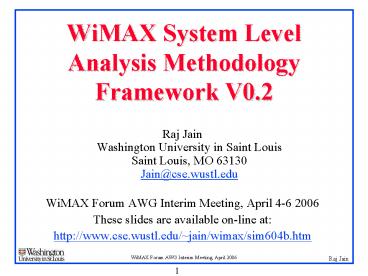WiMAX System Level Analysis Methodology Framework V0'2 - PowerPoint PPT Presentation
1 / 18
Title:
WiMAX System Level Analysis Methodology Framework V0'2
Description:
Quantitative proof of WiMAX Superiority. Marketing vs Engineering: Qualitative vs Quantitative ... Performance impact of various features. 4. WiMAX Forum AWG ... – PowerPoint PPT presentation
Number of Views:92
Avg rating:3.0/5.0
Title: WiMAX System Level Analysis Methodology Framework V0'2
1
WiMAX System Level Analysis Methodology Framework
V0.2
- Raj Jain Washington University in Saint
LouisSaint Louis, MO 63130Jain_at_cse.wustl.edu - WiMAX Forum AWG Interim Meeting, April 4-6 2006
- These slides are available on-line at
- http//www.cse.wustl.edu/jain/wimax/sim604b.htm
2
Overview
- Modules of the System Level Model
- WiMAX Model Components
- Key Specs of Each Module
- PHY Layer Module
- MAC Module
- Transport Layer Module
- Application Layer Module
3
Goal
- Quantitative proof of WiMAX Superiority
- Marketing vs Engineering Qualitative vs
Quantitative - Carriers Need
- Capacity Planning
- Performance Optimization
- Operational Guidelines
- Users Need
- Operational Guidelines
- Vendors need
- Performance impact of various features
4
Goals (Cont)
- WiMAX Real-world Traffic Benchmark
- Workload should exercise bottleneck
- Contents Distribution over WiMAX/Metro-WiFi
- Particularly sensitive to QoS
- Issues not clearly understood
- Need to unite individual models coming from
different sources solving different parts of the
problem - Competition with 3GPP Very thorough analysis
available
5
Modules of the System Level Model
- The system level model will modular with
pre-defined interfaces so that users can easily
interchange modules - The overall model will consist of 4 different
modules - PHY Module
- MAC Module
- Transport Module
- Application Module
- Each module itself will consist of pre-defined
sub modules - The parameters, workload, configurations, key sub
modules for each of these modules are defined
further in this document
6
Modeling Platform
- Preferred Platforms NS2 and Opnet
- Modules in other platforms (e.g., Matlab) can be
used using external calls or by table driven
input/output interfaces - Need to collect known known simple analytical
models also in this document - Analysis Analytical Simulation Measured data
AnalyticalModels
Simulation Models
MeasuredData
Time
7
WiMAX Model Components
Applications (VOIP, VoD, Remote Backup,
)Workload Characteristics, QoS Requirements
Transport and IP Layers (TCP/UDP, IP, RTP,
)TCP/IP Parameters MTU Size, Buffers,
MAC Layer (ARQ, Burst Allocation, FEC,
)Interference from other systems,
Physical Layer (Freq Band, Coding, Antenna, AAS,
OFDM,)Topography (Height, Cell size, Customer
density, )
8
Key Specs of Each Module
- This document defines the following for each
module - Workload Input characteristics
- Configuration
- User controlled Configuration Parameters
- Service Provider Controlled Configuration
parameters - Manufacturer Controlled Configuration Parameters
- Features/Algorithms to be studied/compared
- Metrics Throughput, Delay, Jitter, Availability,
- Assumptions
9
PHY Layer Module
Modem Model
TerrainModel
RF ChannelModel
Signal and InterferenceEvaluation
- Goal To understand the effect of
- Framing TDD, OFDMA
- Ranging
- Power Management
10
PHY Layer Module
- Workload
- Configuration Parameters
- User
- Service Provider Antenna Height, Cell Size,
Customer Density, UL/DL frame times, Sectors,
Bandwidth per sector, channel size, - Manufacturer Freq Band, Coding, Antenna, AAS,
OFDMA, Number of subcarriers - Metrics Bit error rates,
- Features Terrain Model, RF Channel Model,
- Assumptions
- Issues Tight PHY-to-MAC coupling. Need a
separate PHY focus group.
11
MAC Module
Buffering
Scheduler
Admission Control
QoSModel
AASModel
ResourcesModel
PowerControl
ARQ Model
Handover
Framing
- Goal Guidelines for
- Base Station Scheduler Algorithms
- Subscriber Station scheduler algorithms
- H-ARQ
- Admission Control
12
MAC Module
- Workload Packet Burst Arrival Statistics, QoS
service classes, connection setup rate, - Configuration Parameters
- User Subscribed data rate
- Service Provider Buffering,
- Manufacturer
- Metric Throughput in bps, Residual loss rate,
Packet error rate, bit error rate, Average delay,
delay variation - Features to be simulated Power management,
Ranging, Connection setup and release, UL/DL
13
Transport Layer Module
Retransmission
ECN
Congestion Avoidance
SACK
FRR
TrafficShaping
BufferAllocation
DiffServ
Classification
IPv4
MPLS
IPv6
- Goal To understand the effect of
- WiMAX specific TCP Optimizations
- Traffic Shaping, prioritization, buffer
allocation, - Guidelines for use of TCP options/algorithms
14
Transport Layer Module (Cont)
- Workload Burst arrival pattern
- Configuration Parameters
- User TCP/UDP/IP implementations
- Service Provider Prioritization
- Manufacturer Set of scheduling, shaping
algorithms, level of drop preferences, - Metrics Goodput, Delay, Jitter, Loss rate
- Features
- DiffServ, Traffic shaping,
15
Application Layer Module
Web Access
MobileTV
Instant Messaging
StreamingVideo
VideoConferencing
VOIP
Gaming
Music
Telemetry
FTP
Datacasting
VPN Background
- Goal To understand the effect of application
specific options - VOIP Codec, customer usage, connection duration
- Gaming Types of games, user interactivity
- Video Frequency and lengths of video
- Workload Number of users, Application Mix, Usage
Pattern
16
Application Layer Module
- Configuration Parameters
- User Type of usage, Usage frequency
- Service Provider Number of servers, Charging
policies, services - Manufacturer Capacity of servers
- Metrics Number of customers supported
- Traffic Pattern Burst interval statistics,
Burst size statistics, Maximum burst size, - Features
- Required delay tolerances, bit rates required for
each application
17
Summary
- The system level model will consist of 4 modules
- Each module has several well identified
components - Input workload, output metrics, will be agreed
upon - User, Service provider and Manufacturer
controlled parameters will be identified - Key features and assumptions will be identified
18
References
- Application Optimization Scope of Work White
paper - WiMAX Application Usage Profile
- 3GPP, Feasibility Study for OFDM for UTRAN
enhancement, TR25.892 V2.0.0

